Home
Ren's Biking Blog
Idiot's Guide To Valve Trains
Pocketpete started a thread regarding shims, valves, rockers and the reasons therein. I thought I'd put together a VERY basic guide. When I call this an Idiot's Guide I mean it is a guide written by an idiot, not a guide for idiots. Let me make one thing clear. I am not a valve design expert. The things herein are my own opinions based on my experience and my limited amateur engineering knowledge. Don't go telling ya mates down the pub these are facts!
Pushrod.
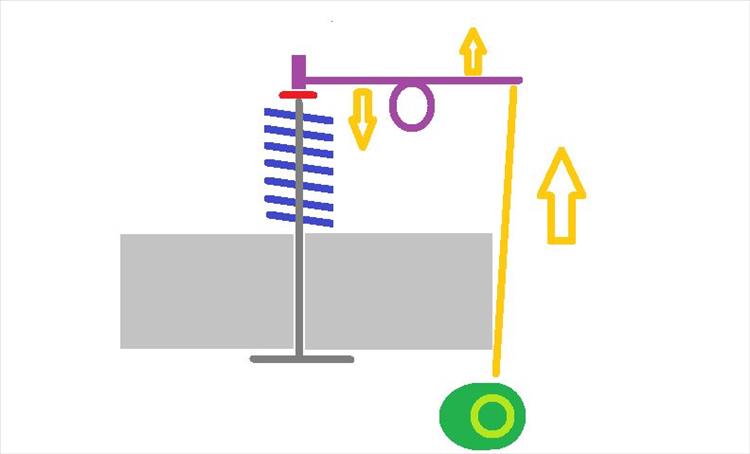
Pushrod
Somewhere deep down in the engine is the camshaft. The lobes push on stiff metal rods that move up. That upward movement pushes one side of a rocker up. This pivots the rocker pushing the other side of the rocker down onto the valve thence pushing the valve down.
This system is still in use on all but the very latest Harley Davidsons, the Enfield 500 single and some Chinese engines copied from the Honda CG125. Both the Harley and the Enfield 500 have hydraulic auto-adjustment otherwise this is typically (but not always) done with screw and locknut.
The advantages of this system. There is either no camchain or a very short one and camchains can wear out. Very simple to maintain (or no maintenance with hydraulic adjustment). Makes removing the cylinder head very simple as there's no camchain and timing to set up.
The disadvantages of this system. There's a lot of metal moving up and down - reciprocating mass - which uses energy and can lead to wear. That moving metal can only move so fast so it doesn't lend itself well to high revving engines.
Overhead Camshaft
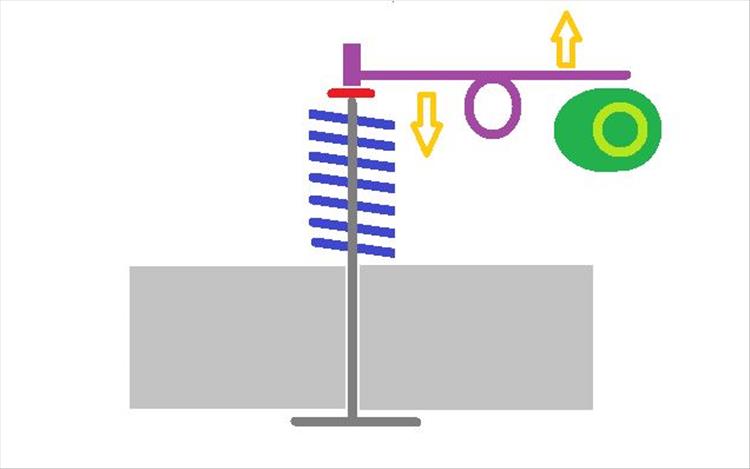
Overhead Camshaft
The crank turns a chain that leads up to the top of the cylinder head. This turns either one or two camshafts. The lobes on the camshaft(s) push one side of the rocker up. This pivots the rocker pushing the other side of the rocker down onto the valve thence pushing the valve down.
This is used on my Honda CBF125 and many many other modern engines.
The advantages of this system. By removing the pushrods there's less reciprocating mass allowing higher revs. 99% of them are easy to maintain with screw and locknut adjustment but it is possible some are shimmed. There are some car engines with hydraulic auto-adjustment.
The disadvantages of this system. As with all engines with the camshaft in the head they're maintenance sensitive. They work and they work well but if there is ANY problem with oil flow or quality reaching the cylinder head the camshaft will eat the soft metal of the head. Cylinder head removal is a pain because of the cam chain and timing. The long camchains (or cambelts) can wear out too.
Bucket Over Shim
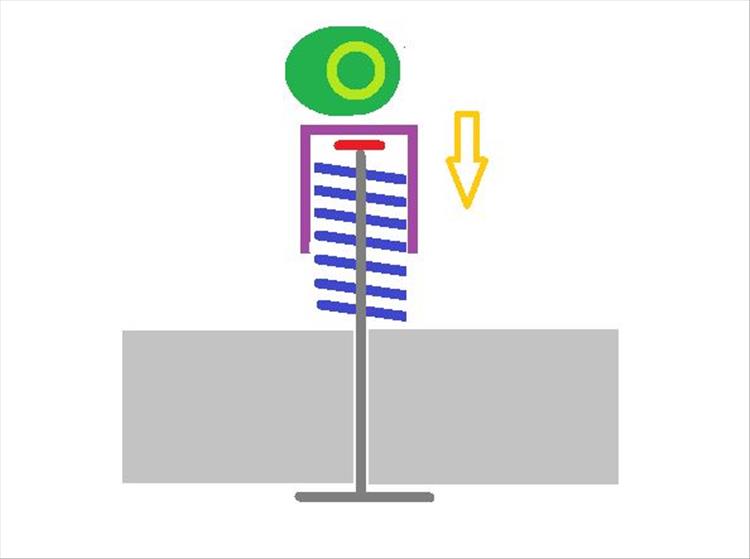
Bucket Over Shim
The crank turns a chain that leads up to the top of the cylinder head. This turns two camshafts. The lobes on the camshafts push almost directly onto the valve via the bucket and the shim.
The advantages of this system. Very little reciprocating mass, only that of the valve, bucket and shim. This allows for very high revs. Very few moving parts also means less to wear out and cheaper manufacturing costs. Most car engines with this system have hydraulic auto-adjustment but motorcycles seldom do.
The disadvantages of this system. Camshaft in head wear risks. Cylinder head removal difficulty. Camchain / cambelt wear. Hellish fiddly to adjust as the camshafts have to come out then be re-timed when re-fitting. You also need a bucketful of shims or be ready to wait as correctly sized ones arrive.
Variations
The above 3 systems are the most commonly found. They are absolutely not the only systems though. Apart from Ducati's Desmodronic system which is other-worldly most are variations of the above. This conversation started over Pocketpete's CB500X. This oddly has a variation on the overhead valve system with a "follower" which is half a rocker.
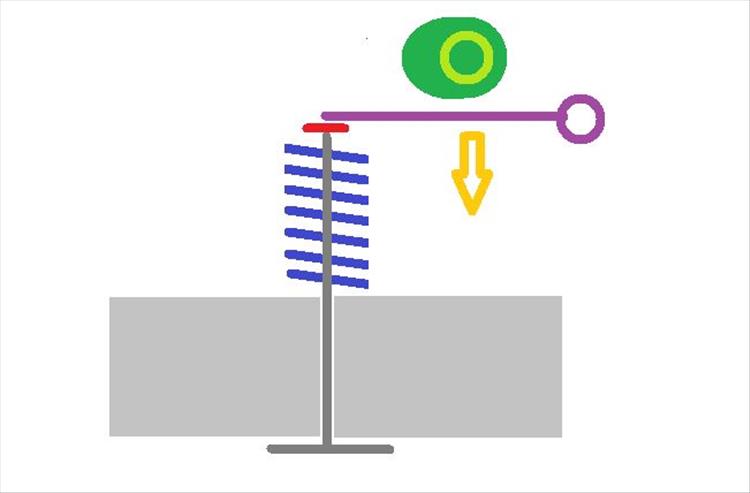 CB500X Valve operation.
CB500X Valve operation.
This could have been fitted with screw and locknut but Honda chose to use shims. The takeaway here is there are hundreds of variations on how to open and close the poppet valves on a regular 4-stroke engine.
Just because your motor is high-revving does not mean it WILL be bucket over shim. Just because your engine is from the 1950s does not mean it WILL be pushrod. I am told the 1990's Japanese home market CB400 Super Four had bucket over shim but without the shims, instead with fully hydraulic auto-adjustment. And that was very very high revving.
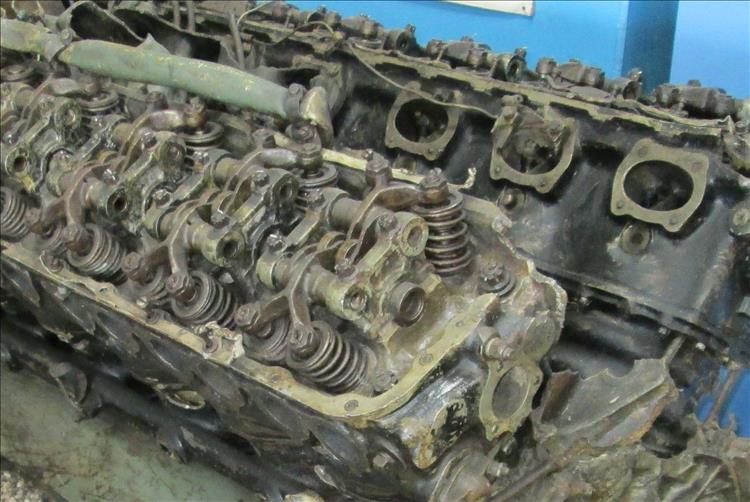
World War 2 downed plane engine. Single Overhead Cam. 4 Valves. Screw and Locknut.
Engine design is very complex. There are ways of making things that should not work... work. There are technical reasons why shims may be better for this motor but not that. Also bear in mind MONEY is a huge part of design. Shims are cheap at the factory but maybe Simone the screw-n-locknut lady is actually faster than PXD-37B the shim computer. Who knows!
I am no expert. I'd welcome your considered opinions, pros and cons, technical reasoning and experiences below.
Reader's Comments
John S said :-
My old Pan had a redline of 8,000 rpm. This is not particularly high yet the engine was bucket over shim. Being a V4 access to the cams and shims was relatively easy once the panels were off but as you suggest getting the cams out then resetting the timing (especially on V4) is a nuisance. With 16 valves, 2 camchains, 2 cylinder heads and plenty of panels it is not the job for the inexperienced mechanic. Luckily I had the help of a friend.
My friend's son's Chinese 125 revs to over 10,000 and that is screw and locknut overhead valve. The GSX750 16v motor was similar to the CB500X pictured above with sort of half followers and that was screw and locknut. It appears there is no specific way to do this.
28/01/2019 11:05:31 UTC
Pocketpete said :-
Ah the world of bikes everything appears simple on the the outside. Which oil to use..
Which coolant....
Which tyres......
Which brakes pads.....
Which spark plugs...
No one actually has an definitive answer to most of these subjective questions. It seems our slant eyed Japanese bike designers have also not got a definitive answer to what is the best tappets design. Let's face it I suppose each design needs difference designs based on price and speed of bike power etc.
My only wish was they design a bike to make it easy to fix and work on. They really haven't got that bit right yet.
28/01/2019 14:59:15 UTC
Ren - The Ed said :-
The problem is Pocketpete is we used to have bikes like that. Take a look at vintage motorcycles. The very early ones were essentially sturdy pushbikes with a simple engine attached. Motorcycles from the 60's were very much nuts and bolts affairs fixable by ordinary people with basic mechanical skills.
The problem was they were - in relation to today's motorcycles - less reliable and needed to be fixed more often. Imagine if we were to remake a say 60's motorcycle with today's metallurgy, precision engineering and digital technology. Oh! They do! My CBF125 is a simple machine. The Enfield 500 is practically the same as it was when first released save for digital ignition, fuel injection and hydraulic tappets. There are plenty of simple motorcycles out there.
We the public who purchase motorcycles are drawn to swish stylish modern machines. We expect things like indicator relays and ignition coils to be hidden from sight. We want to see swooping angular fairings and futuristic designs not breather pipes and sensor wiring. If there were a market for entirely practical pragmatic and therefore possibly ugly motorcycles then they'd be for sale.
We both agree the CB500X is a nightmare to get to the tappets. It was built to a price and that is what attracted our purchases. That price was held down by not concerning themselves with servicing the bike but how it would go together best at a factory. If we want good access and ease of servicing the Enfield Himalayan is quite easy I am told.
28/01/2019 16:44:15 UTC
Pocketpete said :-
Surely a beautiful bike can be made thats easy to work on. It just takes commitment lol.
Let's face it the Himalayan is one ugly beast.
Your little 125 is not a bad looking bike. If you took off those plastic sort of things at the front made a touch more room above the cylinder head for access. Gave it better mudguards and replaced all the rust prone bits with stainless. Hey Presto great bike
28/01/2019 17:39:16 UTC
Steve said :-
Been following the valve threads and esp the cb500x quite closely as it might be my next bike when I retire the NC700.
Thanks for all the info and pics.
As i've got a Himalayan as well I thought I would include a pic of nice blinged up one for Pocketpete.
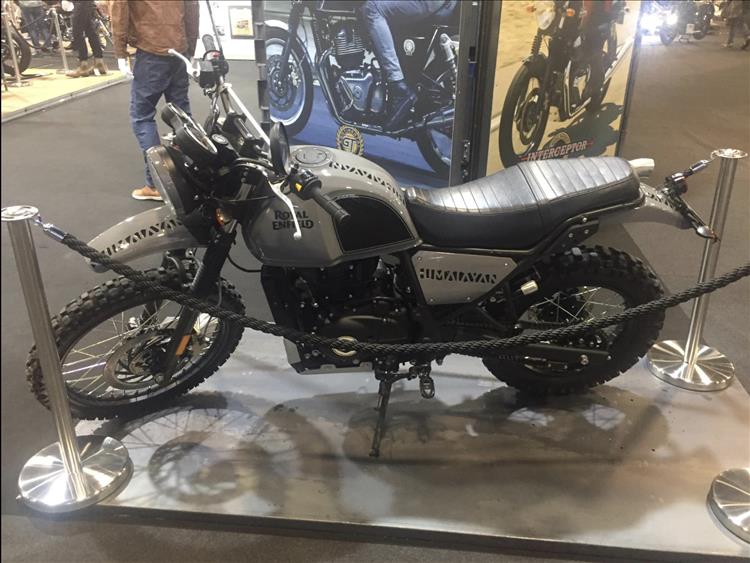 28/01/2019 22:58:43 UTC
28/01/2019 22:58:43 UTC
Borsuk said :-
The Himalayan requires the tank taken off, approx 2 minutes to do as I had mine off 2 days ago as I dropped a nut between it and the top of the frame. Under it there is a small inspection hatch that gives access to the valves for checking. There is cover over the camshaft ( I think) you remove to attach a socket spanner to for rotating the piston and another small inspection hatch for seeing the timing marks. Whole job probably takes less than 1/2 hour.
It seems to have been designed for good access for routine servicing. Even the oil and air filters are easily accessible.
Attached a picture just to upset Ren.
She isnt beautiful but she is function over form in my opinion which tips the scales for me.
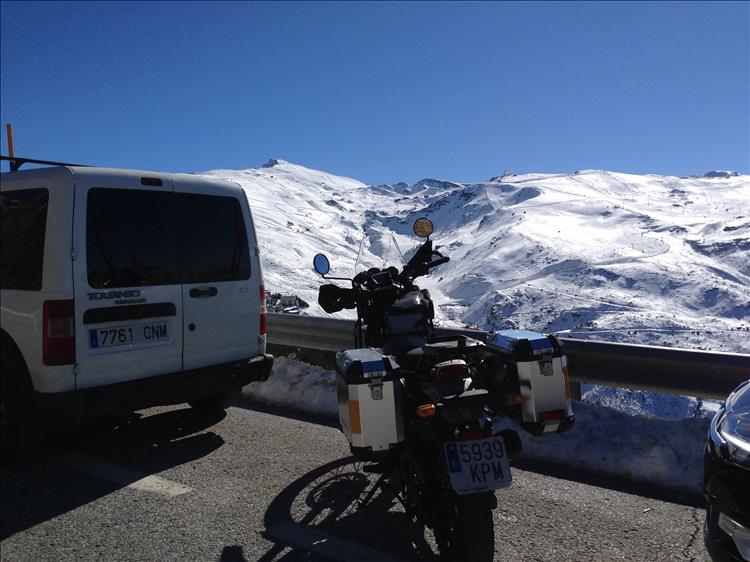 29/01/2019 01:52:08 UTC
29/01/2019 01:52:08 UTC
Ren - The Ed said :-
Yes well contrary to Pocketpete's opinions regarding the Himalayan I think, well, OK it's not a beauty like an Italian bike but it is fine looking. I know if I was high in the mountains and felt the urge to fettle the motor life would be a whole lot easier with the Enfield than it would with the CB500X. There's also a lot fewer panels to break if it should fall over in the mud too. I think you're sailing into the wind here Pocketpete!
Steve - the CB500X's tappets are like most things. Once you know how and what and where and why it's not so bad. It'll be the first time that'll fry your brain. They are a good machine though, I still like mine. Why would you choose the 500X over a newer 750X though?
Borsuk. I hate you and your picture. Git.
29/01/2019 08:36:43 UTC
Steve said :-
Nice picture Borsuk, yes quite quick to get the tank off and valves do look like they will be easy.Function over Form indeed.
Ren, as i get older i am finding the NC heavy, a good saving of 20+ kilos with the cb500x and it is still the same HP i think.
29/01/2019 09:48:45 UTC
Ian Soady said :-
You missed out side valves (and better not mention 2 strokes especially those with disc / reed valves). And what you called OHV is in fact OHC (overhead Cam).
But a good clear basic explanation. Well done.
With respect to shims vs screw type adjusters, I think the theory is that as there are fewer parts to wear and the wearing surfaces are bigger with the shim setup, they should stay in adjustment longer.
As well as bucket over shim you can get shim over bucket, which can be adjusted without removing the camshafts. The Triumph triple engine is (or was) of this configuration.
With regard to PocketPete's comment, bikes were in fact much easier to work on in the past. But then they needed to be. There's a comment attributed to Edward Turner, chief designer of the Triumph twins, that motorcyclists liked nothing better than taking the cylinder head off on Sunday mornings and grinding the valves in. Well, most of them didn't, they just had to......
29/01/2019 10:07:46 UTC
Ren - The Ed said :-
Steve - the CB500X is 47bhp where as the later 750X are about 54bhp. I daresay the differences will be minimal to we normal mortal human beings though. Have you ridden the 500?
OK Ian yes you're right OHC not OHV, I shall correct my error. I personally have not seen a shim over bucket but there is no logical reason why it has to be a certain way around. Imagine though that old Triumph or BSA etc made with modern materials and to modern specifications. I would be fascinated to see how well they ride and how well they'd last.
29/01/2019 10:18:54 UTC
Ian Soady said :-
That's actually the Hinckley Triumph so still AFAIK the case, not the Meriden one (which was OHV).
The big advantage is that the camshafts don't have to be removed. If this is done clumsily then it's easy to cause damage as especially on a multi cylinder bike some valves will be open regardless of engine position and there will be uneven forces on the shaft as the caps are removed. The disadvantage is that you need a special tool but it's not very expensive and in fact very easy to make.
Modern materials? I doubt whether they will look as good after 67 years as the crankcase of my Norton. But I do agree that machining standards are far better these days. There is a (probably apocryphal) story that after Norton production moved from Birmingham to Woolwich, taking the machine tools with them, that the machine operators could never machine some parts within tolerance. They asked one of the blokes from Bracebridge Street and he said "Well, you didn't take the plank did you?". Apparently said plank was used to wedge the headstock of the lathe against the wall so it didn't wobble about.......
Ren would have been quite at home there.
29/01/2019 12:21:48 UTC
Steve said :-
Ren my 12my NC is 35kw so same as the CB500x, I got a 500f for a couple of days while my NC was in the dealers, i remember it felt buzzy after the NC and i probably missed the torque. I sat on the 500x at the motorcycle show, it is a bit taller with the 19 inch from wheel and that should make it higher which suits me. (less knee bends ) Will try one again when the weather warms up.
29/01/2019 12:21:58 UTC
Daf said :-
It's times like these that I marvel at the valve train on my Harley. When I first bought it I spent hours searching the manual and later the internet for advice on how to adjust the tappets. Then I was kindly told that they're self adjusting. Makes all the difference! Also makes servicing a doddle...
Interestingly a lot of cars these days are bucket over shim, but they're not normally adjusted... none of the ones I've seen have a service schedule for valve lash/tappet adjustment...
30/01/2019 14:20:05 UTC
Ren - The Ed said :-
The hydraulic adjust is often the actual bucket. What we see is just a bucket but there's a gallery to the bucket and the hydraulic system within the bucket.
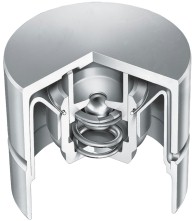 30/01/2019 16:32:52 UTC
30/01/2019 16:32:52 UTC
CrazyFrog said :-
It takes precisely 0 minutes to check and adjust the valves on my 350 Jawa! In fact a full service can be done in about an hour. The only regular maintenance is to adjust the drive chain (it's fully enclosed so this only needs doing once every couple of thousand miles) and change the gearbox oil once a year....
31/01/2019 08:38:32 UTC
Ian Soady said :-
You'll get Ren all excited till he realises it's a 2 stroke......
31/01/2019 15:57:32 UTC
CrazyFrog said :-
I have donned my tin hat and fitted ear plugs in anticipation of Ren's response Ian....
31/01/2019 16:21:22 UTC
Ren - The Ed said :-
... what the... Who the devil invited CrazyFrog to talk about his rattly tattly rind-a-ding smoking machine??
Noooo, no valves or shims noooo. No just piston rings and constantly topping up the 2-stroke hopper and de-cokes and blown seals. So much easier and faster than checking the tappets.
Pfffffft!
31/01/2019 17:03:02 UTC
Pocketpete said :-
That's just mean.... so who's going to explain how hydraulic tappets work.
31/01/2019 17:17:03 UTC
Upt'North said :-
They're hydraulic Pete.
Upt'North.
31/01/2019 18:39:10 UTC
Ren - The Ed said :-
Right then...
 31/01/2019 19:04:00 UTC
31/01/2019 19:04:00 UTC
Ren - The Ed said :-
In the image the pink area is oil under pressure from the engine's oil pump. This flows into the hydraulic tappet which pushed the hydraulic tappet open, much like a very small hydraulic ram on a JCB. This small ram opens up to fill any slack in the system. This actually takes a few seconds and it is not unusual for cars with hydraulic tappets to rattle for a brief moment at startup.
But what happens when the engine warms up? Then the tappet will be too tight surely? Fear not. The hydraulic tappet has a deliberate tiny little leak. As the engine warms if the tappet is tight this little leak allows for the expansion, making sure the tappet does not get too tight.
This is a VERY simplified version. There a non-return valves, springs and the like. Often times the hydraulic tappet can be in the cylinder head, even over the valve that looks just like a regular bucket.
31/01/2019 19:10:34 UTC
Pocketpete said :-
Cheers ren
So the answer is as usual with bikes what appears simple isn't. Maybe the Harley bikes are suddenly looking more attractive if they don't need adjusting. Not sure I could be bothered to clean all the chrome though.
But I'm sure all the biker chicks would flock to see my Harley.
01/02/2019 08:13:40 UTC
Ren - The Ed said :-
The old Harleys without hydraulic adjusters were screw and locknut with pushrod valves. These were easy to adjust anyhow. As for the Enfield 500 - they had an inspection cover on the side of the motor making valve adjustment a 10 minute affair, even for a novice. So the 2 bikes with the simplest adjustment are the 2 bikes that went hydraulic anyhow. Don't ever go thinking the world is a sensible, logical, well thought out place.
01/02/2019 08:56:51 UTC
Ian Soady said :-
Your diagram is _almost_ right. However, hydraulic tappets still need some clearance so there is a bleed from the cylinder / piston arrangement to allow this.
Oh, you've mentioned a tiny leak. This may be your way of saying a bleed.....
01/02/2019 14:56:43 UTC
Ren - The Ed said :-
Yes Ian you're quite right. However this is meant to be a simple guide not a dissertation on hydraulic tappet design. So tiny leak = controlled bleed. We don't want readers panicking that their engine internals have internal bleeding, the NHS has enough on their plate already!
01/02/2019 16:28:27 UTC
Pocketpete said :-
For some reason all I can imagine after all this discussion is a large hydraulic spot slowing oozing green pus yuck.
01/02/2019 19:52:26 UTC
Ren - The Ed said :-
You've been watching too many YouTube pimple popping videos.
03/02/2019 07:40:55 UTC
Ian Soady said :-
"It takes precisely 0 minutes to check and adjust the valves on my 350 Jawa! In fact a full service can be done in about an hour. The only regular maintenance is to adjust the drive chain (it's fully enclosed so this only needs doing once every couple of thousand miles) and change the gearbox oil once a year.... "
Once a year? What are you doing to the poor thing? And adjusting chains every 2,000 miles. I must check the chain on my V50. If I can find it.......
07/02/2019 16:34:07 UTC
Tom McQ said :-
Your valves are VERY leaky! :-D
 07/02/2019 22:42:38 UTC
07/02/2019 22:42:38 UTC
Ren - The Ed¹ said :-
You may also note Tom McQ that there's nowhere for any gasses to enter or exit. This means my engine doesn't work. This makes it environmentally friendly and very economical to run. My genius is wasted.
In the meantime I hope my very oversimplified diagrams have been educational for some readers.
All this will become irrelevant sooner or later. I'll have to learn how to draw electric motors and the like.
08/02/2019 07:30:17 UTC
Name
Comment
Add a RELEVANT link (not required)
Upload an image (not required) -
Uploading...
Home
Ren's Biking Blog